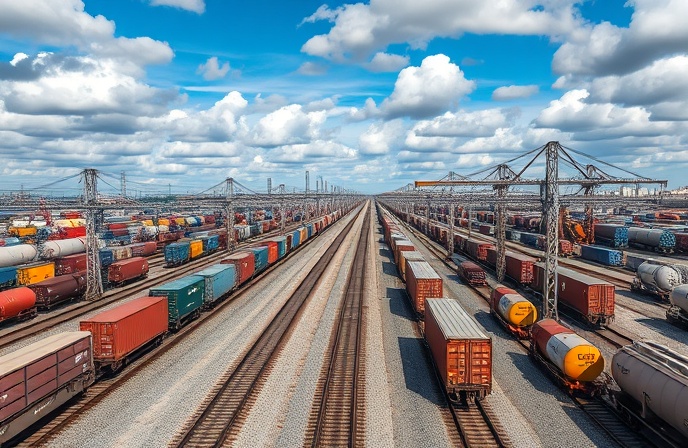Hong Kong-Shenzhen Western Rail: A Cross-Border Vision

This article explores the Hong Kong–Shenzhen Western Express Railway (HKSWER), a proposed cross-border rail link aiming to alleviate transportation pressures in the rapidly developing northern New Territories region of Hong Kong and enhance connectivity with Shenzhen, China. The project’s feasibility is currently under assessment, with initial studies slated for completion in 2022. This detailed analysis will examine the project’s strategic importance, technical considerations, and potential environmental impacts, ultimately evaluating its viability within the broader context of Hong Kong’s and Shenzhen’s integrated transportation network. The proposed railway’s alignment, station locations, construction costs, and the crucial intergovernmental cooperation mechanisms will be critically discussed. Furthermore, the article will consider alternative transportation solutions and technological advancements that could enhance the efficiency and sustainability of the project.
Strategic Rationale for the Hong Kong–Shenzhen Western Express Railway
The impetus for the HKSWER stems from the escalating demand for efficient transportation infrastructure in the rapidly expanding northern New Territories. Existing rail lines, such as the East Rail and West Rail lines, are facing increasing capacity constraints due to development projects in the area. The proposed railway aims to address this by providing a direct link between the western New Territories (near Hung Shui Kiu and Ha Tsuen) and Qianhai, a rapidly developing technological and economic hub in Shenzhen. This connection will not only improve intercity travel but also facilitate cross-border economic integration and potentially stimulate development along the corridor. The HKSWER is envisioned as an extension of the MTR Corporation’s Northern Link, a significant infrastructure project already underway in Hong Kong. The integration of these projects will create a more comprehensive and efficient transportation network for the region. This strategic alignment with existing and planned infrastructure is key to the project’s long-term success and integration into the broader regional transportation network.
Technical and Operational Considerations
The HKSWER’s design and construction will require careful consideration of various technical and operational factors. The route alignment will be a crucial determinant of the project’s cost-effectiveness and environmental impact. The selection of optimal station locations will depend on detailed passenger demand forecasts and accessibility considerations. Moreover, the project’s cost will be a major factor, requiring careful financial planning and potential investment from both Hong Kong and Shenzhen authorities. The establishment of a dedicated office in Shenzhen highlights the commitment to effective cross-border cooperation, critical for the efficient execution of such a large-scale project. This cooperation will extend to defining operational procedures, maintenance responsibilities, and safety protocols. Effective collaboration will be crucial for the seamless integration of the HKSWER into the existing transportation networks of both cities.
Environmental Sustainability and Technological Innovations
Environmental concerns will play a significant role in the HKSWER’s design and implementation. Minimizing the environmental footprint through environmentally conscious construction practices and the adoption of sustainable technologies will be crucial. The integration of heat recycling HVAC (Heating, Ventilation, and Air Conditioning) systems and other energy-efficient technologies could significantly reduce the railway’s carbon footprint. Furthermore, exploration of alternative transportation solutions such as Light Rail Transit (LRT) systems or automated, self-driving trains for potential extensions of the Northern Link should be considered. These innovations could enhance the efficiency, sustainability, and overall passenger experience.
Post-Pandemic Reassessment and Future Outlook
The COVID-19 pandemic has significantly impacted global travel patterns, making it necessary to reassess the initial passenger demand projections for the HKSWER. A post-pandemic analysis of travel habits is crucial to ensure that the railway’s capacity aligns with future demand. This reassessment will involve a detailed analysis of commuting patterns, tourism trends, and economic activities in the affected regions. The findings will be incorporated into the final design and implementation of the HKSWER to ensure its long-term viability and effectiveness. The findings of this study could influence the type of rolling stock, frequency of services, and potentially even the scale of the project itself. This adaptive approach to planning is critical for the success of long-term infrastructure projects in a dynamic and evolving environment.
Conclusions
The Hong Kong–Shenzhen Western Express Railway represents a significant infrastructure investment with the potential to transform transportation connectivity between Hong Kong and Shenzhen. The project’s success hinges on careful planning, effective cross-border collaboration, and a commitment to environmental sustainability. The initial studies, set for completion in 2022, will play a critical role in shaping the project’s feasibility and design. Careful consideration of factors such as route alignment, station locations, construction costs, and operational procedures are paramount. Furthermore, the ongoing reassessment of passenger demand in the post-COVID-19 era is essential for ensuring the railway’s long-term viability. The incorporation of sustainable technologies and the exploration of innovative transportation solutions, such as LRT systems or automated trains, can further enhance the project’s environmental performance and overall efficiency. The HKSWER’s success will not only alleviate transportation pressures in the northern New Territories but also contribute to the broader economic integration and development of the region. The project’s long-term impact will depend on its ability to adapt to evolving circumstances and maintain a focus on delivering a sustainable and effective transportation solution. The collaboration between the Hong Kong and Shenzhen governments, the MTR Corporation, and other stakeholders will be essential for navigating the complex challenges and realizing the full potential of this ambitious project. The careful consideration of all these factors will ultimately determine the success and long-term viability of the HKSWER.



